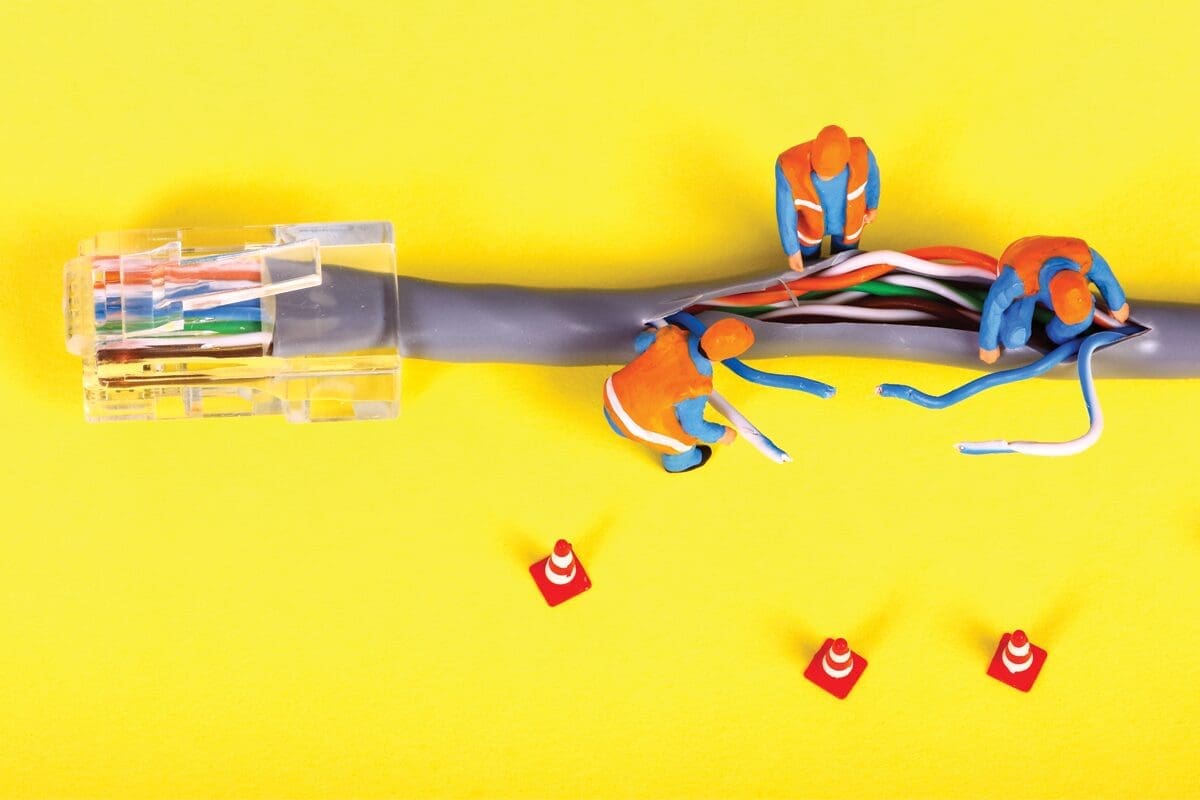When it comes to networks inside a building, most of us picture invisible data zipping through walls and ceilings. But there’s a lot happening behind the scenes that determines how fast, reliable, and future-proof your network really is.
Copper Cabling: The Old Standard
Copper cabling—Cat5e, Cat6, Cat6a—has been the backbone of networks for decades, but its limits are often misunderstood. Technically, manufacturers claim copper can transmit data up to 300 feet—but in real-world buildings, that number rarely holds up. Cables seldom run in a straight line. They twist around walls, bend around corners, and pass through tight conduits. All these twists and turns reduce the effective range to about 175 feet before signal quality starts to drop. Why the discrepancy? It all comes down to the challenges copper faces inside walls, ceilings, and conduits.
Copper’s Hidden Challenges
1. Bends and Twists
Every corner, twist, and loop in a cable run adds resistance. Copper relies on electrical signals, and sharp bends can distort or weaken those signals. Even a few tight corners can reduce effective range by tens of feet.
2. Interference and Crosstalk
Copper is vulnerable to electromagnetic interference (EMI) from nearby electrical wiring, fluorescent lights, and other devices. Signals can “bleed” between adjacent wires—a phenomenon called crosstalk—which further limits performance and security.
3. Distance Limitations
The 300-foot figure is a theoretical maximum under ideal, straight-line conditions—essentially 100 meters, or about 330 feet. Once you factor in patch panels, connectors, and practical routing, usable range drops significantly—often to 175 feet or less.
4. Environmental Factors
Temperature fluctuations, humidity, and building materials can all impact copper performance. High heat or moisture can accelerate signal degradation over time and cause cable physical degradation leading to cable replacement.
5. Bandwidth Constraints
Even within its effective distance, copper has limits on how much data it can carry. Cat5e supports up to 1 Gbps, Cat6 up to 10 Gbps (for shorter distances), and Cat6a can extend that slightly—but future-proofing networks with higher bandwidth needs is challenging. Some cables tout higher bandwidth, but it’s largely a pseudo-numbers game—heavier, high-gauge wire that doesn’t truly solve the challenges of ever-growing network demands.
Fiber Optic Cabling: The New Standard
Enter fiber cabling—the modern solution for high-performance networks. Unlike copper, fiber uses light instead of electricity, which means:
- No signal degradation over long distances—runs up to 18 miles are possible.
- Immune to interference and crosstalk.
- Future-proof bandwidth—supporting ever-increasing data demands.
- Long lifespan—many fiber networks last 30+ years with minimal maintenance.
- High security—fiber is extremely difficult to tap without detection, helping safeguard sensitive data and critical operations.
For buildings, government agencies, and enterprises looking to future-proof their infrastructure, fiber is the gold standard. It handles more bandwidth, supports faster speeds, and delivers rock-solid reliability where copper starts to struggle.
Explore fiber and Passive Optical Networking’s (PON) widespread impact in: PON Isn’t Emerging – It’s Already Everywhere (You Just Havent’t Been Told About It).
Bottom Line
Copper worked in the past—but its qualities are far too limited in the face of newer technology. Fiber optic cabling is faster, longer-lasting, and ready to handle the networks of tomorrow. It has already become the standard for high-speed data centers and the de facto solution for many enterprise-grade campuses.
When planning a network, knowing the limits of copper and the power of fiber ensures your building’s data flows smoothly today—and well into the future.
Need more convincing? Read and share this article: How to Turn a Skeptic into a True PON Believer.
